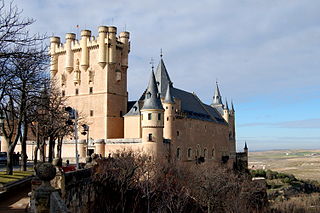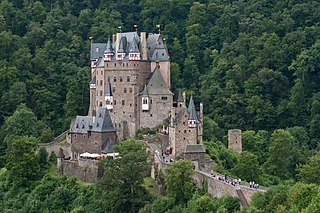
A citadel is the core fortified area of a town or city. It may be a castle, fortress, or fortified center. The term is a diminutive of "city" and thus means "little city", so called because it is a smaller part of the city of which it is the defensive core. Ancient Sparta had a citadel as did many other Greek cities and towns.

Mecklenburg is a historical region in northern Germany comprising the western and larger part of the federal-state Mecklenburg-Vorpommern. The largest cities of the region are Rostock, Schwerin, Neubrandenburg, Wismar and Güstrow.

A castle is a type of fortified structure built during the Middle Ages by predominantly the nobility or royalty and by military orders. Scholars debate the scope of the word castle, but usually consider it to be the private fortified residence of a lord or noble. This is distinct from a palace, which is not fortified; from a fortress, which was not always a residence for royalty or nobility; and from a fortified settlement, which was a public defence – though there are many similarities among these types of construction. Usage of the term has varied over time and has been applied to structures as diverse as hill forts and country houses. Over the approximately 900 years that castles were built, they took on a great many forms with many different features, although some, such as curtain walls and arrowslits, were commonplace.

A town is a human settlement. Towns are generally larger than villages but smaller than cities, though the criteria to distinguish them vary considerably between different parts of the world.

Les Baux-de-Provence is a French commune in the Bouches-du-Rhône department of the province of Provence in the Provence-Alpes-Côte d'Azur region of southern France. It has a spectacular position in the Alpilles mountains, set atop a rocky outcrop that is crowned with a ruined castle overlooking the plains to the south. Its name refers to its site: in Provençal, a bauç is a rocky spur. The name bauxite is derived from the village name when it was first discovered there by geologist Pierre Berthier in 1821.

A defensive wall is a fortification usually used to protect a city, town or other settlement from potential aggressors. In ancient to modern times, they were used to enclose settlements. Generally, these are referred to as city walls or town walls, although there were also walls, such as the Great Wall of China, Walls of Benin, Hadrian's Wall, Anastasian Wall, the Cyclopean Wall Rajgir and the metaphorical Atlantic Wall, which extended far beyond the borders of a city and were used to enclose regions or mark territorial boundaries. In mountainous terrain, defensive walls such as letzis were used in combination with castles to seal valleys from potential attack. Beyond their defensive utility, many walls also had important symbolic functions – representing the status and independence of the communities they embraced.

A fortification is a military construction or building designed for the defense of territories in warfare, and is also used to solidify rule in a region during peacetime. The term is derived from the Latin fortis ("strong") and facere.

Eltz Castle is a medieval castle nestled in the hills above the Moselle River between Koblenz and Trier, Germany. It is still owned by a branch of the same family that lived there in the 12th century, 33 generations ago. Bürresheim Castle, Eltz Castle and Lissingen Castle are the only castles on the left bank of the Rhine in Rhineland-Palatinate which have never been destroyed.

Châteaubriant is a town in western France, about 350 km (220 mi) southwest of Paris, and one of the three sous-préfectures of the Loire-Atlantique department. Châteaubriant is also situated in the historical and cultural region of Brittany, and it is the capital of the Pays de la Mée.

A manor house was historically the main residence of the lord of the manor. The house formed the administrative centre of a manor in the European feudal system; within its great hall were held the lord's manorial courts, communal meals with manorial tenants and great banquets. The term is today loosely applied to various country houses, frequently dating from the late medieval era, which formerly housed the gentry.
City rights are a feature of the medieval history of the Low Countries. A liege lord, usually a count, duke or similar member of the high nobility, granted to a town or village he owned certain town privileges that places without city rights did not have.

Calp is a coastal town located in the comarca of Marina Alta, in the province of Alicante, Valencian Community, Spain, by the Mediterranean Sea. It has an area of 23.5 km² and a population density of 920 persons/km². The town is located 67 km from the city of Alicante and lies at the foot of the Natural Park of Penyal d'Ifac.

Feldkirch is a medieval city in the western Austrian state of Vorarlberg on the border with Switzerland and Liechtenstein. It is the administrative center of the district Feldkirch. After Dornbirn, it is the second largest town in Vorarlberg in terms of population, with slightly more inhabitants than the state capital Bregenz. The westernmost point in Austria lies in Feldkirch on the river Rhine, at the northern tripoint border of Austria, Switzerland, and Liechtenstein.

Dill is an Ortsgemeinde – a municipality belonging to a Verbandsgemeinde, a kind of collective municipality – in the Rhein-Hunsrück-Kreis (district) in Rhineland-Palatinate, Germany. It belongs to the Verbandsgemeinde of Kirchberg, whose seat is in the like-named town, and it is home to a castle ruin that bears the same name.

Miranda del Castañar is a municipality located in the province of Salamanca, Castile and León, Spain. As of 2016 the municipality has a population of 426 inhabitants.

Berat Castle, also referred to as the Citadel of Berat and castle quarter, is a fortress overlooking the town of Berat, Albania. It dates mainly from the 13th century and contains many Byzantine churches in the area and Ottoman mosques. It is built on a rocky hill on the left bank of the river Osum and is accessible only from the south. It is situated at an elevation of 214 metres (702 ft).

A bergfried is a tall tower that is typically found in castles of the Middle Ages in German-speaking countries and in countries under German influence. Friar describes it as a "free-standing, fighting-tower". Its defensive function is to some extent similar to that of a keep in English or French castles. However, the characteristic difference between a bergfried and a keep is that a bergfried was typically not designed for permanent habitation.

A Zwinger is an open area between two defensive walls that is used for defensive purposes. Zwingers were built in the Middle Ages and Early Modern Period to improve the defence of castles and town walls. The term is German and usually left untranslated. However, it is sometimes rendered as "outer courtyard" presumably referring to the subsequent role of a Zwinger as a castle's defences became redundant and it was converted into a palace or schloss, however, this belies its original purpose as a form of killing ground for the defence. The word is linked with zwingen, "to force", perhaps because the Zwinger forced an enemy to negotiate it before assaulting the main defensive line. Essenwein states that the "main purpose of this feature was so that the besieging force could not reach the actual castle wall very easily with battering rams or belfries, but had to stop at the lower, outer wall; also that two ranks of archers, behind and above one another, could fire upon the approaching enemy"

The Architecture of Albania is a reflection of Albania's historical and cultural heritage. The country's architecture was influenced by its location within the Mediterranean Basin and progressed over the course of history as it was once inhabited by numerous civilisations including the Illyrians, Ancient Greeks, Romans, Byzantines, Venetians, Ottomans as well as modern Austro-Hungarians and Italians. In addition, missionaries, invaders, colonisers and traders brought cultural changes that had a large profound effect on building styles as well as techniques.




















